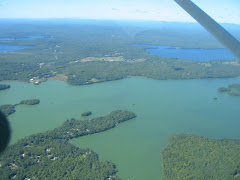
Today I got to participate in one of those aviation “firsts” that you dream about. You’ll have to read on to find out what “ITT” was…
One of my first recollections of the wonder of aviation was when I took an Air New England flight from Lebanon NH to LaGuardia NY. I was probably just in my double digits age wise (gosh that seems a long time ago) when my mom waved good-bye to me and I climbed into the back of the long silver tube with the high wing and oil stained turboprop nacelles. My seat was under the wing near one of those looming engines, and I can recall how I stared at the landing gear coming out of the bottom of it. I was struck by the size and power of such a structure. There were huge blades emanating from the front of it and as the flight attendant closed the door, the high pitched whine started and soon the blades gathered speed and the whole plane started to shake with energy. Such sounds and energy were new to me, as I’d been dropped off at the airport in an old Subaru. I’d watched these beasts depart from behind the chain linked fence, wondering if perhaps I’d ever get to fly something so massive, and here I was now sitting just feet from those spinning blades as a passenger to “N Y C”. What could be cooler? The plane taxied and soon the engines really came to life, pulling us down the runway with the gear somehow magically disappearing inside the engines and within an hour we were on final approach into LaGuardia over the water and in one of the coolest cities on earth. If this was aviation…I wanted more!
Well today after practicing some spins in a Cessna 150 with another flight instructor, I was given the opportunity to start up a set of Pratt and Whitney’s myself. Uhh, OKAY! I grabbed a pen and paper hoping to glean some facts from the briefing, as I’ve read countless articles on “hot starts”, “ITT”, “torque”, and “low idle”. Now I could experience them up close, as terms like these escape us mere pistons folks!
Walking up to the large nacelles (also streaked with exhaust gas oils by the way), I learned from my friend that these were PT6-27’s which use a starter that then turns into a generator (cool). The air flows into the bottom of the nacelles and does a 180 degree turn up into the compressor where it’s mixed with fuel from 14 nozzles and “fire” from 2 igniters to create…you got it… LOTS OF THRUST! This is a “free turbine” which means that the power plant and propeller are connected by some sort of “clutch-like” mechanism that builds pressure as the turbine spins, eventually moving the propeller unit with it (at much fewer rpms of course). Having checked the oil and making sure everything else looked in place, we closed the nacelles and climbed into the cockpit.
My friend explained the checklist procedures that are used before starting. The dials (of which there are many) that I needed to keep an eye on included the “ITT” gauge and the "% rpm". "ITT" stands for Inter-turbine temperature, and you don’t let it go over 1090 degrees C. In summary the battery is turned on, then the primary boost pump comes on, quickly followed by the right ignition/starter switch. The large feathered prop begins to spin while I hear the familiar high pitched whine coming from the engine compartment (this was going to be neat). I could already feel my pulse increase, thinking “I’m actually going to do this!” Fairly soon thereafter (about 3 revolutions of the now slowly turning propeller) the “% rpm” went over 12 % and we moved the condition lever forward from cutoff to “low idle”. The sound reminded me of the low “woof” heard when you light your gas grill a bit after the propane’s been on, and suddenly the % dial and ITT began to climb. My friend said in all his years he’d never had a “hot start” but this is where your eyes stay glued to the ITT and if it climbs over redline headed to the 1090 C number you’d immediately pull the fuel off. Our temps stabilized near the 500 degree mark with 50% rpms indicated and “Voila!” -I’d done my first turbine start successfully!

The procedure is similar with the second engine and soon both props were whirring with the familiar hum I’d heard from that old Air New England bird. After bringing the props out of feather we checked the gauges and all looked fine. After an easy and uneventful shut down we spent a few more minutes reviewing checklists and other safety features, including dual elevator trim systems, autopilot disconnect, crossfeeds and secondary boost pumps and emergency gear extension systems. Someday soon I’ll probably get to fly one of these turboprop beasts. I’m told to hang onto my hat as climb out is a little different from the Cessna Skyhawks I’m used to commanding. But all planes respond to lift, weight, thrust and drag so I’ll not be too surprised…just aware that some have more thrust from “ITT” than others!
Here's a youtube link to a start up...(more fun when you're in the cockpit!)...
http://www.youtube.com/watch?v=JenaHHKcbZ0&feature=related

